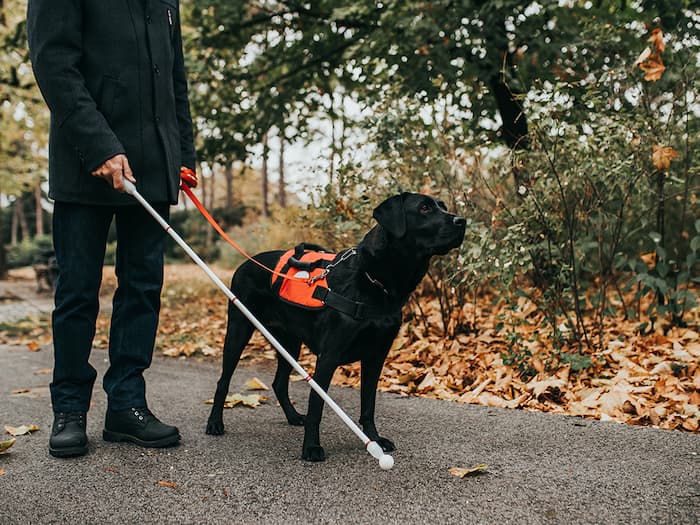
How to Train a Service Dog? All You Want to Know
How to train a service dog? Determine if your dog can be a service dog, teach them the basics, train them on eye contact, make sure that your service animal is as confident off the leash as they are on it, last, they are well-socialized and trained dogs.
A service dog can assist you in navigating and participating in your environment more effectively if you have a physical or mental disability. The ideal solution is typically a professionally trained service dog, but it is not necessary. As long as you have the time and patience for it, you can absolutely train a dog to be your service animal.
Here, we’ve gathered some of your most common questions about how to train your service dog on your own without a professional trainer.
Table of Contents
What is a Service Dog?
According to the Americans with Disabilities Act (ADA), a service dog is a canine that has been trained to carry out specific tasks for the benefit of a person with a disability. From autism to PTSD to blindness, this can occur.
The training of a service dog typically focuses on meeting the companion’s highly specific needs. Because they’re trained to such a high degree, service dogs can be expensive and the waiting lists for a perfect match can be long…as in years long.
In fact, these highly skilled and specialized dogs frequently have corporate sponsors and are occasionally associated with charities, which can offset the costs, but the need frequently exceeds the amount of assistance available.
Even though they would greatly benefit from having a service dog in their life, some people may unfortunately not be able to afford one due to the waiting list, the cost, and the matching process.
How to Train Your Own Service Dog?
The dog’s temperament, the disability they are being trained to assist with, and other factors will all affect how they are trained. Some legal actions have failed. Usually, it is possible to accomplish.
Determine If Your Dog Can Be a Service Dog
You must determine if your dog is capable of performing the job before beginning the drawn-out and demanding service dog training process. There are several questions you need to ask as a service dog owner, such as:
- The dog should be over 6 months old and neutered or spayed to prevent distractions from other dogs during training. Older dogs who suffer from medical conditions like diabetes and arthritis might not be amenable to training.
- The temperament of the dog is important because a service dog must be cool under pressure. It shouldn’t act violently toward other dogs, but it also shouldn’t completely ignore them. For assistance dogs with hearing and vision, this is crucial.
- How long can the dog focus? A dog should be able to focus for long enough to handle training sessions. How can you be sure the dog won’t become distracted while you could be in danger if it is unable to learn commands because it is easily distracted by its surroundings, particularly in public places?
- What restrictions does the dog have? You must take into account any restrictions the animal may have and how they may affect you. For instance, a larger breed would be preferable to a smaller one if you needed a dog to assist with balance.
Before deciding to train your pet, you must provide the answers to these crucial questions. The best service dogs have good command-response skills, are calm and self-assured, intelligent, young, and in good health. Almost any breed of dog can be trained for the job if they meet the necessary requirements, so it doesn’t always depend on the breed. You might want to think about getting a trained dog if your dog doesn’t fit this description. Step 2 should be taken if it does.
Teach Them the Basics
The fundamental abilities for a service dog or other service animal aren’t particularly challenging to learn. Service animals must be socialized with people and other dogs, be well-behaved when not on a leash, and have confidence in all situations.
The best way to guarantee that your dog matures into a sociable and self-assured adult is through socialization. Ideal times for socialization are between 3 and 20 weeks of age. Puppies should be handled frequently by a variety of people, exposed to a variety of sounds, and taught to be alone (to reduce separation anxiety). Any interactions with the puppy must be kind and cordial, never hostile. Moreover, you must watch out for any signs of aggression from them.
Potty-training your dog is essential to prevent messes indoors, but it also teaches them to “go” on command in appropriate places. Getting them a crate gives them a secure space they want to keep tidy. Keeping them in the crate and letting them out to immediately go relieve themselves teaches them that “going” outside is good.
For your dog to understand their boundaries, leash training is also crucial. When it’s appropriate, your dog should learn to focus on you rather than the surroundings.
Before training your dog to become a service animal, these three fundamental abilities are the most crucial ones you’ll need to teach them. It is also beneficial to teach them basic obedience commands such as “sit,” “heel,” and “down”.

Eye Contact
You’ll need to train your dog to maintain eye contact if you want to assess their level of focus and make sure that they will be working only for you. You can ask a friend for assistance in trying to divert the dog’s attention away from you, and you can reward the dog with treats whenever they are concentrated on you for a certain period of time. If you want to make sure that your dog remains focused, gradually increase the time.
Off-Leash Training
Making sure that your service animal is as at ease off the leash as they are on it is the next step in service dog training. While you are conducting your training sessions, your dog must respond to you and you alone. For this step, all you need to do is remove your dog’s leash (in a safe environment) and encourage your pet to follow straightforward commands you would use outside. When you are confident, start slowly introducing your dog to public areas outside after practicing this several times to make sure they understand what to do.
Specialize!
Your service dog’s job requirements will determine the final step in this guide. They are now well-trained and socialized dogs. They know basic commands like “sit” and “stay,” are calm and responsive on- and off-leash, and can maintain eye contact with you. From there, you will train them for particular jobs based on what you need their job to be.
- Hearing service dogs must be trained to react to ringing phones, doorbells, or fire alarms. To achieve this, teach them to sit in front of you and carry out a particular action each time the sound trigger occurs. Also take into account sound clicker training.
- When they spot the warning signs of a panic attack or another type of psychiatric distress, psychiatric service animals warn their owners. Dogs, by nature, frequently approach the scene and attempt to assist, so you can teach them by simulating a panic or anxiety attack. After rewarding them for trying to assist, you change their behavior so they respond by acting when a panic attack strikes.
- Service dogs that aid in mobility provide assistance to people with physical disabilities. These dogs can easily be trained by rewarding them when they retrieve an object on verbal commands. Say the item’s name, for instance, and then point to it so that they can retrieve it. Practice will help them pick up the command.
As you can see, the particular steps for training a service dog depend on what you need them to be able to do.
How Many Hours of Training Does a Service Dog Need?
According to training recommendations, your dog needs at least 120 hours of instruction.Your dog requires at least 30 hours of practice in public on top of those additional 120 hours. Taking your dog to a variety of locations where you frequently go is typical of public practice.
- For instance, if you frequently visit the neighborhood mall for shopping, take your dog there so that it gets used to moving around and acting appropriately in stores where there may be a lot of distractions.
- Typically, you can anticipate your service dog’s training to take about two years.
- Remember that puppies and untrained service animals do not have the same access rights as fully trained ones. If the proprietor or manager of a restaurant or shop allows your dog, they are acting out of goodwill. You must honor their request if they decline.
Do I Need to Register My Service Dog?
No, your dog does not need to be registered or certified in order to comply with the ADA. There are voluntary registration or certification programs in place in some cities, states, and regional organizations. You cannot, however, be fined for not enrolling your dog in these programs. You may choose to do so at your discretion.
- No store managers or owners may request documentation proving your dog’s registration or certification. It’s generally preferable to withhold proof if requested because doing so only serves to perpetuate the myth that registration or certification is necessary.
Does My Dog Need a Vest Or Tags in Public?
Service dogs are exempt from wearing identification under the ADA.It is entirely your choice whether you think it is more convenient for your dog to wear a vest while working. A vest is not required by US law, and people cannot bar you from entering without one.
For the purpose of setting them apart from pets, therapy and emotional support dogs frequently sport vests. These canines aren’t, however, protected by the ADA as service animals and aren’t always allowed in public spaces that typically forbid dogs.

At What Age Should I Start Training My Dog?
Around 8 weeks old is when most professional trainers begin working with puppies.Puppies who start training this early can potentially “graduate” and become full service dogs at 18-24 months. It’s never too early to begin training a service dog, especially with fundamental commands and obedience exercises.
A puppy as a training partner also enables you to establish expectations early and uphold them consistently.
Types of Service Dogs
German shepherds and labradors come to mind when we think of service dogs, but any dog can make an excellent service dog because each dog’s unique characteristics can be matched with a variety of companion needs.
Any breed of dog is qualified to be a service dog, per service dog certifications; there are no breed or weight restrictions.
After determining that your dog is capable of helping you, you should think about your dog’s health if you want to train them to be a service dog. It is crucial that service dogs are capable of handling the job because they are working dogs who will be committed to caring for their companion.
Request a thorough evaluation of your dog from your veterinarian. Your dog’s age will be another important factor. Your dog should be old enough to begin formal training but still be young enough that you can count on him for many years of service after his training is finished.
Can My Dog Be a Service Dog?
There are some requirements to be aware of before you can train your dog to be a service dog. Not all dogs can make good service dogs, and trying to train a dog who isn’t cut out to be that kind of working dog will only make you both miserable.
When assessing your dog, keep the following things in mind:
How old is your dog?
A first-time visit to the vet is crucial, along with follow-up exams. Even the healthiest pets can suffer from conditions like diabetes and arthritis, so adding service animal duties is not a good idea.
Additionally, it is advisable to neuter all service dogs to make them less aggressive and to prevent females from working while in heat. The minimum age for dogs is six months, and they should be past the puppy stage.
What kind of personality does your dog have?
Some dogs are aggressive while others are submissive, and in many cases, this isn’t “good” or “bad”—it’s not that simple. Between these two extremes, there is a very small window of temperament that is appropriate for a service animal.
Your dog may be a good fit for service work if she is cool, collected, and alert while also being responsive and obedient. With additional resources for testing ideas, Paw Rescue has an excellent primer on dog temperament.
What Breeds Make the Best Service Dogs?
While certain breeds, such as golden retrievers, labrador retrievers, and even German shepherds, are popular choices for service dogs, any dog meeting the requirements can be the ideal companion for those in need. What matters most is their temperament and the disability they are assisting with.
The ideal service dog is:
- Calm
- Confident
- Intelligent
- Motivated
- Social (just nottoo social)
- Non-reactive
These are only a few criteria you can use to determine whether your dog has a good chance of developing into a wonderful service animal. Visit our dog temperament guide for more information on identifying a dog’s temperament. The American Temperament Test Society also offers assessments.
Knowing what disability the dog is being trained to help is also a good idea. A larger breed may be necessary for someone who needs a dog to aid in balance, while a small dog could make an excellent service dog for diabetes alertness.
Service Dogs Vs. Emotional Support Dogs
Although they have some important distinctions, service dogs and emotional support dogs have historically been treated incorrectly as interchangeable.
Despite the fact that both breeds of dogs can be very helpful and reassuring to their owners’ companions, service dogs are trained specifically to perform a specific task for their owners in public settings. Whether or not they have received any training, emotional support dogs are usually able to benefit their owners just by being around.
It’s also very important to understand that a service dog is a working dog and because they are performing this very important function for one person, they are not a pet.
An emotional support dog is a wonderful companion who can be a great comfort to their owner, but he has not received individualized training that would make him qualified to carry out specific tasks for their owners. In contrast to a service dog, which aids a person with a disability, an emotional support dog is a wonderful companion who can.
Due to this very significant distinction, service dogs and their owners are entitled to certain rights in public spaces that companion dogs are not. For example, the ADA states that service dogs and their owners are allowed to accompany their owners in all public spaces, with the exception of situations where the dog cannot be controlled by his owner or is not housebroken.
Final Thoughts
You can use these suggestions if you’re trying to develop a relationship with your service animal or want to save some money by using a DIY method because the ADA does not mandate any special program for service animals or for their public access. Remember: If you decide that this process is too challenging, you can always get in touch with a professional trainer. You can also seek advice from qualified trainers of service dogs.
Read about SpiritDog Training Reviews




